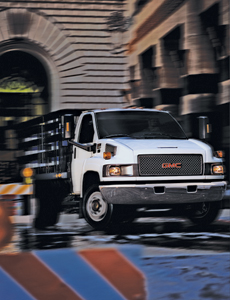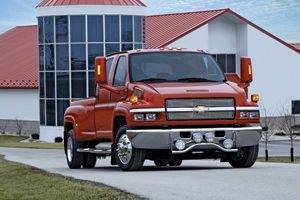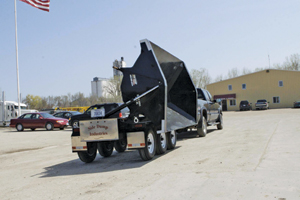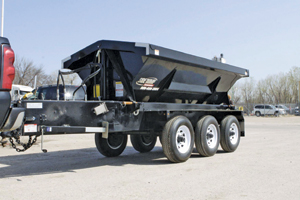End of the Road

One week after filing for Chapter 11 bankruptcy, General Motors announced June 8 that it would be terminating the production of medium-duty trucks, the Chevrolet Kodiak and the GMC Topkick. In 2008, 20,000 units were sold, 10,000 less than the previous year. Despite poor sales because of the worldwide economic plunders, GM’s commercial truck sales were down only 24 percent in 2008, a fairly strong number compared to the overall market sector decline of 31 percent. According to the automaker, however, the vehicles had been selling poorly for several years, so it was no startle to the company when they decided to pull the plug on the Kodiak and Topkick.

The company issued a statement reading, “After four years of working with multiple potential buyers, General Motors has decided to wind-down its medium-duty truck options. Production of the Chevy Kodiak and GMC Topkick medium-duty trucks will cease by July 31, 2009.”
Navistar International Corp. was the top prospect to purchase the lines in 2007. However, the tentative agreement between the two companies was never finalized, and the deal expired in August of 2008, which, along with market uncertainty, surfaced as a factor in the wind-down decision. GM is also actively seeking a buyer for the Saab brand and has recently sold Saturn to Penske Automotive Group. It is speculated that Chinese heavy equipment maker Sichuan Tengzhong Heavy Industrial Machinery will officially aquire Hummer in the third quarter as preliminary agreements are already underway.
Though the trucks will be no longer and have no foreseeable future of returning, GM promises that customer service will still be paramount. Chevy/GMC dealerships will continue to service these trucks no differently than before. The two-year, unlimited bumper-to-bumper warranty will also be left unchanged for the remainder of GM’s inventory of the Kodiak and Topkick.
Several new lines are being introduced throughout 2009 and 2010 as the Topkick and Kodiak are being phased out. Most notably, GM is releasing the Chevy Volt, an electric car that will be able to travel 40 miles solely on battery power. CEO Fritz Henderson has commented on small cars, saying how they are “representing one of the fastest growing segments in the United States and the world,” which may be an insinuation of the direction of GM’s future.
Henderson has assured the roughly 400 salaried people employed as workers on the medium-duty lines that they would either be relocated to a different plant or given an attrition program. Employees will be moved based on the plant’s local seniority agreement.
The GMC Topkick and Chevrolet Kodiak were introduced to the GM line in 1980 and have been produced at Flint Assembly in Flint, Mich., the same facility where light pickups, including the GMC Sierra and Chevrolet Silverado, are manufactured. GM intends to maintain production on the pickups.
The rest of the American truck market will continue, warily but nevertheless, with big names like Ford’s Ranger, E-Series and F-Series, International’s DuraStar and CityStar, and Dodge’s Dakota, Ram and Sprinter. The future of Dodge is unknown, but Ford looks to remain a competitive player in the light- and medium-duty truck market.
Automakers’ Financial Woes
GM is obviously not the sole American truck manufacturer experiencing money problems caused by the recession. Chrysler declared bankruptcy even before GM, forced by President Obama on April 30, which made it the first American automaker to file for bankruptcy protection since Studebaker in 1933. The automaker is planning on closing 789 of its dealer franchises, which is nearly 25 percent of its dealer base, and has sold most of the company’s assets to Italian automaker Fiat after a lengthy back and forth with United States Supreme Court Justice Ruth Bader Ginsburg. Since the Fiat deal closed and current CEO of the Italian automaker Sergio Marchionne was named head of the new company, Chrysler Group LLC, the factories that had been temporarily closed since May 4 have been set to reopen. The shut down resulted in a loss of $100 million per day. The U.S. Treasury Department is providing Chrysler with $12 billion in loans to overcome its dire money situation.
In another perilous financial circumstance, GM has doled its company shares out to several holders: 60 percent to the American federal government, 17.5 percent to United Auto Workers (UAW), 12.5 percent to the Canadian government and 10 percent to unsecured bondholders. It is expected that existing GM shareholders will be taken out of the percentage entirely. Although most of the company’s stake went to the federal government, Fritz Henderson was promised to remain the decision maker. He states 3 years as a very viable turnaround number. By next fall, GM plans on ending the franchise agreements of 1,100 underperforming dealerships nationwide, though approximately 49 dealership closing decisions to date have been reversed based on a reviewing process. Overall, 98.7 percent of GM’s dealers offered wind-down agreements have accepted.

The question at hand may be how Ford Motor Co., the car company rounding out the Big Three, avoided bankruptcy after being hit with similar loss. Ford gave itself a financial cushion back in 2006 by mortgaging all of its assets to borrow around $25 million.
Many may think the word “bankruptcy” as taboo, but declaring Chapter 11 has given two out of the Big Three American automakers an opportunity to reorganize their companies and restructure their spending as to hopefully avoid something like this happening again.
Leanne Butkovic is a contributing editor to Compact Equipment, based in Peninsula, Ohio.
Hefty Haulers
Side Dump Industries Offers Unique and Easy-to-Use Trailer Options
Nebraska-based trailer maker Side Dump Industries sells one of the most distinctive haulers on the market. Its one-of-a-kind trailers have a 50-degree dump angle, the most of any side dump manufactured, which allows for a faster and cleaner release than other trailers.

Frame sizes range from 118 in. to 44 ft, and tubs can hold from up to 41.5 cu ft to 27 cu yds of heaping material. With the High Side Revolution Series, the operator can haul up to 60 cu yds. Side Dump’s trailers’ towing requirements are reasonable. The Mini can be hauled by an ATV or tractor, the Contractors Series can be hitched to a pickup or tractor and the Construction Series requires a tractor truck.

These trailers require no specific technique or special skill to use — an idyllic situation for do-it-yourselfers. However, a DVD on safety, operation and maintenance is included to ensure a harmless and effective dump. All U.S. Department of Transportation rules, regulations and requirements apply.
Major manufacturers of the Side Dump trailers are SmithCo, Trail King and Circle R. For more information, visit www.sidedumpindustries.com.

Comments are closed here.